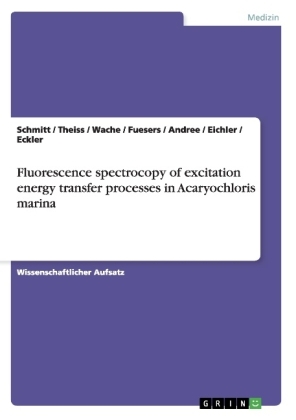
Fluorescence spectrocopy of excitation energy transfer processes in Acaryochloris marina
Seiten
2010
|
10003 A. 3. Auflage
GRIN Verlag
978-3-640-77014-4 (ISBN)
GRIN Verlag
978-3-640-77014-4 (ISBN)
- Titel nicht im Sortiment
- Artikel merken
Wissenschaftlicher Aufsatz aus dem Jahr 2007 im Fachbereich Medizin - Biomedizinische Technik, Technische Universität Berlin, Sprache: Deutsch, Abstract: Time- and wavelength-resolved fluorescence spectroscopy is an appropriate tool for quantitative and non-invasive investigations of living cells. Short measurement times with low excitation light intensities are necessary to observe variations of the fluorescence due to changes in the metabolism of the sensitive biological organisms.With new techniques the fluorescence dynamics can be monitored simultaneously in a broad spectrum during a very short measurement time. That provides information about the spectral differences of the fluorescence dynamics which can vary in correlation with the metabolic changes.The interaction of the photosynthetic subunits and especially the mechanisms regulating the energy transfer are presently interesting and open fields in photosynthesis research.The phototrophic cyanobacterium Acaryochloris marina contains membrane extrinsic PBP antenna complexes and mainly Chl d containing membrane intrinsic core antenna complexes which absorb light and transfer excitation energy to the reaction center.The results of our studies suggest a fast excitation energy transfer kinetics of 20-30 ps along the PBP antenna of A.marina followed by a transfer with a time constant of about 60 ps to Chl d.Very often cells or cell fragments are kept at low temperature to decelerate ageing processes. Living cells of A. marina which were stored at 0°C for some time showed a reduced excitation energy transfer from the PBP to the Chl d antenna, which partially recovered when the sample had been kept at 25 °C for a short time.The reduction of the excitation energy transfer might be caused by a mechanism that decouples the PBP antenna under cold stress conditions avoiding photo damage of the reaction center of PS II.
| Erscheint lt. Verlag | 16.12.2010 |
|---|---|
| Sprache | deutsch |
| Maße | 148 x 210 mm |
| Gewicht | 60 g |
| Themenwelt | Medizin / Pharmazie ► Medizinische Fachgebiete |
| Naturwissenschaften ► Physik / Astronomie | |
| Technik | |
| Schlagworte | acaryochloris • fluorescence |
| ISBN-10 | 3-640-77014-5 / 3640770145 |
| ISBN-13 | 978-3-640-77014-4 / 9783640770144 |
| Zustand | Neuware |
| Haben Sie eine Frage zum Produkt? |
Mehr entdecken
aus dem Bereich
aus dem Bereich
Kompaktes Wissen, Sprachtraining und Simulationen für Mediziner
Buch | Softcover (2020)
Urban & Fischer in Elsevier (Verlag)
CHF 55,95


